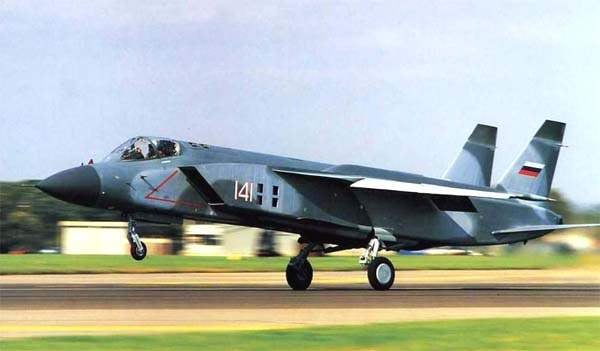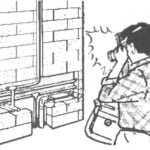 In the late 1960-ies started to combat service in the Mediterranean and in the Atlantic, the new classes of ships of the Soviet Navy — anti-submarine cruiser “Moskva” and “Leningrad”. To enhance the combat effectiveness of the ASW anti-submarine cruisers carried on Board each 14 helicopters Ka-25ПЛ and Ka-25PS.
In the late 1960-ies started to combat service in the Mediterranean and in the Atlantic, the new classes of ships of the Soviet Navy — anti-submarine cruiser “Moskva” and “Leningrad”. To enhance the combat effectiveness of the ASW anti-submarine cruisers carried on Board each 14 helicopters Ka-25ПЛ and Ka-25PS.
The third improved anti-submarine cruiser “Kiev” aircraft weapons carried on Board, in addition to anti-submarine helicopters Ka-25, light attack aircraft Yak-36M with vertical takeoff and landing. The main objective of the attack was the destruction of mobile, fixed terrestrial and marine enemy targets in visual appearance, as well as aviation support of combat operations of ground troops.
In parallel with the completion of the first stage of state tests of the Yak-36M in OKB A. S. Yakovlev in 1974 he completed the study of a supersonic fighter-perehvatchik Yak-36МФ (Yak-36P) one polyammonium engine. This work was a logical continuation of the implementation of OKB receiving Secretary of the CPSU Central Committee on defence Dmitry Ustinov to create aircraft with vertical takeoff and landing VTOL) to expand the combat capabilities of anti-submarine cruisers “Kiev”.
As a result of studies performed by the Bureau and institutions of Minaviaprom and 30-m Central research Institute of the Ministry of defence in November 1977, came the decree of the government, which in 1978, the design Bureau of A. S. Yakovlev issued tactical and technical requirements. Homework provided for the establishment of supersonic fighter-interceptor with one of lifting and sustainer engine R79V-300 weapon system C-41 with vertical takeoff and landing Yak-41 and Yak-41УТ with access to state flight tests in 1982 and 1983, respectively. As part of the armament of the Yak-41 was planned, in particular, pravlenie missiles “air — air” R-3S, R-60M, R-73 and R-27.
The new fighter was supposed to equip the aircraft carrier “Novorossiysk”, “Baku” and “Tbilisi”.
Work on the new aircraft was carried out under the supervision of the Deputy General designer A. S. Yakovlev, a leading designer of the machine was A. G. Matveev. During conceptual design, the developers of the fighter-interceptor once again gave preference to the combined power plant developed for the Yak-38.
In the spring of 1979, the preliminary design of the fighter-interceptor and its layout with a single lifting and sustainer engine presented to the Commission of the Ministry of defence. At the same time, the Commission considered the materials of the EDO multi-purpose fighter with enhanced armament and a combined power plant. The result of the Commission’s work was the instruction of the Ministry of aviation industry of the development of OKB And Yakovlev preliminary design and construction layout of a fighter with a combined power plant.
In the fall of 1980, the Commission of naval aviation we reviewed the preliminary design and layout of the Yak-41. In the final version of the Yak-41 was created as a multi-purpose machine with combined power plant, consisting of podyemnaya and two hoisting engines. This version of the power plant with electronic control provide a vertical takeoff, or takeoff with short takeoff from the deck length of 120 m with a maximum takeoff weight of 19.5 tons.
In parallel with the design work in 1982 and 1983 were carried out theoretical studies to increase payload and loitering time the Yak-41 during takeoff with short takeoff or jumping and using external fuel tanks PTB.


The Yak-41:
1 — rod LDPE; 2 — radiotransparent Radome radar With-41 “beetle”; 3 — antenna system of national recognition “Password”; 4 — cap sensor of the angle of attack; 5 — the visor of the cockpit canopy; 6 — movable part of the lamp; 7 — lifting turbojet engine RD-41; 8 — upper leaf compartment of hoisting motors; 9 — anti-surge air intake panel; 10 — rocket “air — air” medium-range R-77 (RW-AE); 11 — container of the braking parachute; 12 — antenna radio systems of short-range navigation Pion; 13 — rudder; 14 — the tail-Board air navigation light; 15 — nozzle lifting and propulsion turbojet engines R-79V-300 in the position of vertical take-off; 16 — movable hisotrically fold; 17 — wheel 880×230 mm; 18 — strut suspension; 19 — fold gastralia lifting engines; 20 — fold lower compartment lifting engines into position; 21 — fold Nephi front landing gear; 22 — wheel 500х125 mm; 23 — strut: 24 — the engine nozzle R-79ІІ-300 in a marching position; 25 stekatel gases right beam; 26 — jet rudder channel of the course; 27 — gas-dynamic of the comb; 28 — fairing main landing gear; 29 — operating rod gototraining fold; 30 — hinge joint of the folding wing; 31 — retainer flaps; 32 — tail boom; 33 — transition beam: 34 — paleovirology stabilizer; 35 — flaps; 36 — Aileron: 37 — static electricity discharger; 38 — missile “air — air” R-73; 39 — fold compartment lifting engines in the initial position; 40 — emergency PVD; 41 — landing light; 42 — rapid-aircraft cannon GSH-30; 43 — jet rudders of the channel Bank; 44 is a valve of additional air supply; 45 — by-pass valve upper sash; 46 — radiotransparent Radome on the tip of the keel; 47 — left side panel; 48 — left panel; 49 — sight; 50 right panel; 51 display; 52 — right panel; 53 — Central panel
Because of the problems faced by the developers of the engine R-79V-300, in the autumn of 1983 the Military-industrial Commission under the Council of Ministers of the USSR adopted a decision to postpone the release date on the test aircraft in 1985.
In the spring of 1986, the Soviet government adopted a decree on the establishment of multi-purpose shipborne aircraft Yak-41 M, and its training version of the Yak-41УТ using scientific and technical reserve on the Yak-41.
By this time there were new types of weapons, which allowed to significantly expand the combat capabilities of the VTOL aircraft to intercept air targets — aircraft and cruise missiles — and to put effective missile and air strikes on ships and ground targets. Sighting system of the machine is formed based on the onboard digital computer, incorporating on-Board multi-function radar М002 (C-41) “beetle”, the weapon control system, helmet-mounted target designation system and laser-TV guidance system. The display of information is carried out on the multifunction display on the right panel of the dashboard and the display on the windshield of the cab.
Navigation system allowed to determine the aircraft’s location using a ship or coastal radio systems, and use a satellite navigation system. It includes remote and traktornogo control of the aircraft. The complex provides automation of virtually all regimes of flight, including the landing in terms of meteorological conditions 30×200 m.
A feature of the layout of the machine was the tail, on two short and thick beams.
The wing of the plane, like its predecessor, had a folding console.
The main structural material of the Yak-41M are aluminum alloy; 26 percent of the mass of the airframe are accounted for by composites. Used them in the tail, the toes of the wing and the flaps.
The armament of the Yak-41M, excluding guided missiles “air — air” and the GSH-301 cannon, entered anti-ship missiles KH-31A and Kh-35. as well as anti-radar KH-31P.
The power plant includes polyaminopropyl turbofan Р79-300 with a thrust of 15,500 kgf with a rotary nozzle and two elevating RD-41 thrust of 4100 kgf.
For testing structures built four machines: the first was conducted the static strength test; for the second (hull number 48) was working with combined propulsion by ground stand; the third (the first prototype with hull number 75) was used for flight testing at the stage of the main constructor; the fourth (pre-production standard with tail number 77) was designed for conducting state tests of the aircraft and its systems. Serial production planned at the Saratov aviation plant.
March 9, 1987, test pilot OKB A. A. Sinitsyn performed on the Yak-41 M first flight. During the tests it became clear that years of hard work to produce the desired results.
In the spring of 1991 one of the experienced Yak-41 M equipped with control loads to perform a record flight. On this machine 11 — April 25 A. A. Sinitsyn established 12 world records, including climbing, lifting most of the load and lifting with cargo in 1 and 2 tons at maximum height in the class “N”.

High dynamic characteristics of the system of rotation of the thrust vector of PMD possible to implement on the aircraft only takeoff with short takeoff (WRC), but supershort vertically inclined take-off (VNV). In the first case, the weight can be increased by 2700 kg and the second at 800 kg. This allows you to operate Yak-41 M for vertical and supershort take-off from the site of 30×40 m 30×250 or m — with short takeoff.
In 1987 has ended the trials of aircraft carrier “Baku”. At the end of the year he entered service and was enrolled in the red banner Northern fleet. Shortly before the end of the test the cruiser was renamed the “Admiral Gorshkov”
In accordance with the program state flight tests in September — October 1991, the flights were continued at Severomorsk, where was stationed a cruiser and where 24 September test pilot A. A. Sinitsyn, and A. V. Yakimov flew from LEAH on the first and second prototypes.
30 Sep, the test team began flight tests, and both the prototype flew with a coastal aerodrome on the deck of the “Gorshkov”, and In A. Yakimova it was the first landing on the deck of an aircraft carrier. A successful landing on the deck instilled confidence in the success of the VTOL. Due to the difficult weather conditions, the testing of the airplane were conducted in the waters of the base.
5 Oct test pilot V. A. Yakimov during landing of the second prototype of the Yak-41M (tail number 77) on the deck with a strong side wind and the ensuing swings exceeded the maximum allowable vertical rate of descent, resulting in the accident. When they hit the deck of the ship main landing gear of the aircraft struck the fuel tank, and spilled on the deck kerosene erupted from the exhaust gases of the power plant At the command of the head of the flight Yakimov ejected from the flames of the plane and landed in the cold water of the Barents sea autumn. Chair K-36ЛВ installed on the Yak-41, in this almost desperate situation worked perfectly and survived the test pilot was picked up by a boat.
After the accident at the “Gorshkov” flight tests of the Yak-41 M stopped.
The plane was created under the designation Yak-41 M, but in 1991, on the eve of Aero-space show in France, the General designer of MMZ “Speed” of A. N. Dondukov took an unexpected decision to rename the car in the Yak-141. This put the Yak-141 is in par with developed in OKB aircraft: Yak-112, Yak-130 and Yak-142. Testing continued on the second plane. In September 1992 the aircraft had a chance to attend an air show in Farnborough (England) and three years later to become a participant of the air show in the Moscow region town of Zhukovsky.
The situation in the country after the collapse of the Soviet Union, when unstable funding was delayed for years, perfecting many of the experimental planes that are in the final stage of state tests of the Yak-41 was doomed. And the heroic efforts of OKB trying on own funds should continue to be refined, not given the desired result was Not successful and attempts to find a foreign investor for finishing the plane.
Performance characteristics

The work stopped, and the aircraft became an exhibit of the Central air force Museum in Monino near Moscow.
Meanwhile, our overseas colleagues were not going to turn this promising direction. Today work on a supersonic multipurpose aircraft short takeoff and vertical there are continuing in full swing. Two fighters with short and vertical takeoff — X-32A and X-35A, designed for one of the largest competition program JSF (joint strike aircraft) the two largest American companies “Boeing” and “Lockheed Martin”, the Ministry of defense has selected for further development, the X-35A. Besides the United States will acquire this aircraft, many countries from the UK to Australia. By the way, some know-how of the Yak-41 M, such as the design of the nozzle of the main engine, the Americans have borrowed from us, and this has helped them OKB A. S. Yakovlev.
Ten years on VTOL aircraft in the Yakovlev design Bureau gained valuable technological advance. The chief designer of the Yak-141 Konstantin Popovich, the firm, despite the difficult situation, we are still professionals and have the necessary production capacity. And if Russia again will remember about VTOL, it will not have to start with a clean slate.
N. YAKUBOVICH



